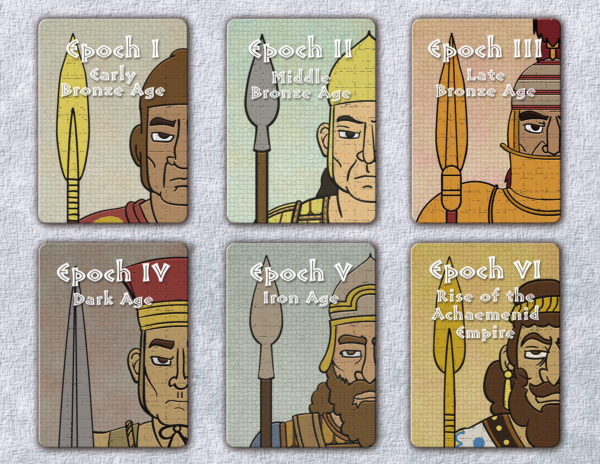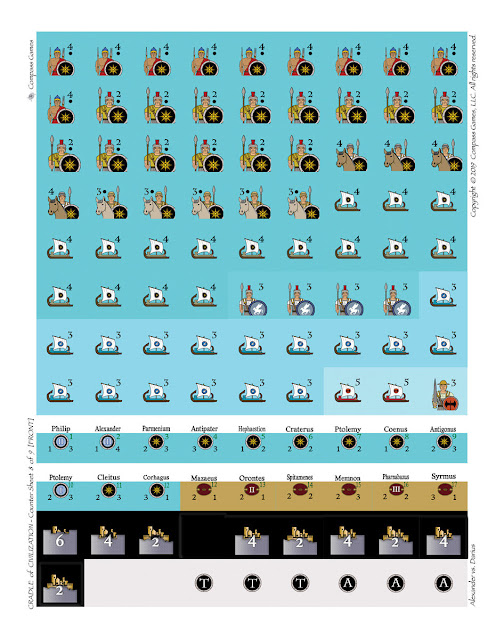Most important is that you can read locations' names when counters are placed on them.
The counters too have drawn mixed reactions, again largely through contrasts with those in the original game. Once more my preference is for the new style which, like the map, I find easier on the eye. I particularly didn't like the overwhelming pink of the Japanese counters and the white blossom emblem and the dominating image of the American bald eagle in the first edition. No doubt if that earlier imagery really pleased you, then the new style may be less to your taste.
Criticism of the new counters has mainly focused on the blue of the US counters - a heavy negative view has been expressed that it is too dark and that the numbers lack distinction and so are hard to read. As someone with not the sharpest [old] eyes, I considered them neither too dark, nor had any problems reading the numbers or symbols.
The second criticism - some quite vehemently expressed- is that there is a slight imperfection in some of the cutting as the next image reveals.
If you zoom in on the Interpid [sic] Franklin, you can see what is meant. Personally, this is no big deal and when on the map it is neither noticeable nor impedes play. [If I was bothered at all it might be about the misprint of Intrepid!] I mention this criticism merely for those who might have seen some of the more extravagant outbursts about poor quality control, which I don't think is justified.
For me the major improvement is the decision to make the naval units square, the air units hexagonal and the land units round. This simple distinction is very helpful during play. Your mix of forces is obvious at a glance, instead of having to work your way through a uniform pile of counters. Other simple physical aspects that I welcome are the attractive Task Force screens...
and the Battleboard, which continues the more restrained colours of this new version.
The final elements are the rule book and scenario book. Both are a major step up from the typical average quality paper of the time to today's high quality gloss printing. Also the layout has been much improved in the rule book, though the rules themselves are [and here, I'm relying mainly on memory, as I no longer have the first edition] virtually identical. The significant change is the doubling of Transport costs accompanied by a similar doubling of Transport available. This may seem a pointless exercise, but it does away with the first version's often occurring division sums involving fractions!
Rule and Scenario Books
On the face of it, the basic rules - a mere 16 pages - seem more than accommodating, especially when merely looking at their apparent brevity and well spaced layout, but this can be deceptive. In part, this is caused first of all by the organisation of the rules into Core Concepts followed by the General Course of Play. The former are often closely tied to the latter with information in the one being needed or relevant to understanding the other. This doesn't help either in learning the rules or finding crucial aspects of them again, as you play the game.
Each turn is based on the seemingly old-fashioned Igo-Ugo system, but the inclusion of a Reaction Phase introduces more interaction than at first appears likely, as does some of the asymmetrical elements of each player's turn.
In all, the Sequence of Play breaks down into ten Phases. What happens and when can sometimes seem strange; for example the first Phase is Economic. In the Japanese player's half of the turn this allows the transfer of Oil Pts and/or DD units, whereas in the Allied Player's half of the turn the Economic Phase is totally different, as the Japanese Player may first undertake anti-submarine warfare followed by the Allied Player undertaking submarine action.
There is a lot of novelty, both here and elsewhere. It makes for a unique and fascinating experience, but it doesn't ease the learning process. The next Phase: Reinforcements, for all its brevity, is not a simple matter and took repeated checking to make sure not only that I understood them properly, but that I realised the consequences of my choices. Almost all the information pertains specifically to the Japanese player, while the Allied player is left by contrast with a very, very brief and simple set of actions.
Each Player's turn involves no less than five Phases that involve movement of one sort or another. For the Phasing player there are the First [Major] Deployment Phase, the Operational Movement Phase, the Return to Base Phase and the Second [Minor] Deployment Phase while the Non-Phasing player has a Reaction Phase, which inevitably involves movement. Each time there are mixes that incorporate different distances and requirements depending on type of unit whether air, naval or land, which Phase it takes place in and different numbers of Transport Points for both sides, while sometimes the cost of movement is paid for in oil but only by the Japanese player.
Remembering accurately and consistently all the differing factors and qualifications is not only a formidable task, but one which I've found slows the game down considerably. What I find even more frustrating is the lack of any explanation of the design intent behind many of the actions. For example, the already mentioned Transport allowance is a very important factor and I appreciate the restraints and limitations that are imposed on both players. Still I would like to understand better the reasoning behind some of the variations for each player. Similarly, considering the significantly large distances involved in the sea hexes, I wonder why aircraft exert air zones that impact on and restrict the movement of naval vessels and supply lines.
With Movement itself so complex, it's no surprise that Combat is convoluted too. Even the Submarine Attack Segment has three steps, before we even reach the Battle Segment. The latter is divided into:-
Battle Board Preparation Step
Air Combat Step [broken down into 4 stages]
Surface Combat Step [broken down into 4 stages]
Sea Control Step
Land Combat Step [broken down into 5 stages]
Administrative Step
The Battle Board is certainly both an attractive and useful feature that helps in this process.
This looks even better when units are laid out on it, but weaving your way through the steps and bearing in mind all the nuances of the rules is again a slow and steady process.
Units are divided into Carrier Task Forces and Bombardment Task Forces, while Naval, Air, Long Range Air and Land units all have separate boxes on the Battleboard, if they are not part of a Task Force. Fortunately, not all types of units and types of Combat occur in every battle that takes place. What seems strange is that, despite a fair degree of complexity, air and land combat ultimately involves rolling modified fives or sixes to hit.
Naval combat demands a different approach, amplifying a very familiar system from the classic Avalon Hill game, Victory In The Pacific [VITP]. In this, one player - the one without Air Superiority - lines up his ships and the other matches one for one. If one player has more ships involved than the other player, they can assign the excess ships in any way they wish.
However, one side or the other can then choose to withdraw. Though the player who chooses to withdraw relinquishes the ability to fire, any withdrawing ships that are faster than their attacker avoid being fired on - another feature seen in VITP. If neither player withdraws, then fire is simultaneous, but unlike air and land combat, the hit number needed is found by cross-referencing Fire Power against Defence Rating.
Up to this point, I had really liked this part of the system. It involved no modifiers [hurrah!], yet took account in a simple way of different types of ships firing at each other. However, now you have to look up the effect of the hits on each ship by rolling two dice plus any possible modifiers and comparing this with the ship's defence rating to see if it is damaged or sunk!
A smaller engagement, though still encompassing all types of combat
To add to all this, you have to calculate the differing effects of damage to carriers, to ships, to air units and to land units. There are no simple consistencies across your forces as to modifiers, rules for influencing factors or how to calculate them or their effects. Some damage causes losses to the Transport Pool, some damage causes a ship to be placed on the turn track, some damage causes a reduction in strength and so it goes on ...
There are many cumulative elements and factors with no logical connections to make remembering them easier. As a result I found myself checking and rechecking rules and constantly referring to the Player Aid card for modifiers.
The final substantial component of this game, the Scenario Booklet, is intended to help you thread your way through the rules. As such, it might have been better to present them in reverse order and that is partly how I used them. The seventh and last Scenario, Battle of Midway is just that. It needs only the Battleboard and a very small number of units, mainly carriers. Frankly I would have appreciated similar micro-scenarios designed to practice such things as Naval Combat or Land Combat and Amphibious Landings. The next shortest [two Turns] is Scenario 6 Guadalcanal Campaign is billed as a short learning scenario too, but suffers from needing an additional series of special rules to explain rule elements that are not used.
Scenarios 3, 4 & 5 [3 Turns, 10 Turns and 4 Turns respectively] reduce playing time by presenting portions of the whole game. The latter also shortens play by using only a portion of the map. Finally, Scenarios 1 & 2 present the war in its entirety, the only difference being that Scenario 1 [classed as the game's main scenario] omits Turn 1 : Pearl Harbour.
These large Scenarios would benefit greatly from Set-Up Play Aids to reduce set up time and help sort out the many units and where they are placed on the map, along with the position of various important tracking markers on the board.
Last and by no means least, as it is 17 pages long, is a massive Example of Play. [incorrectly labelled Scenario 2, it is in fact Scenario 1] that takes you through all of Turn 2. Once again high hopes of its help were not wholly realised. Despite its extensive thoroughness or perhaps because of it, following the information and understanding it, especially the numerical aspects and calculations, proves a major undertaking in itself. Much of the time I found myself having repeatedly to sit, rules in hand, to make sense of how the numbers were derived.
This is not a game for the faint hearted, nor is it one that can easily be taught by a player however familiar with the rules to someone who isn't. Perhaps, if this were to be your go-to strategic level game for the Pacific war with expectations of frequent play, your efforts may be rewarded, but as yet they elude me.
As always many thanks to Phalanx Games for their kindness in providing a review copy of Fire In The Sky.















































Follow Us